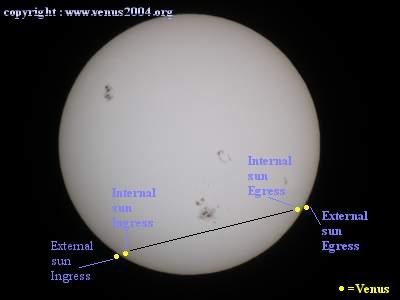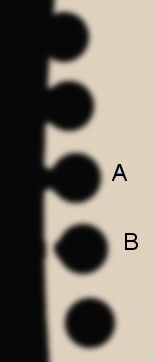|
|
Venus2004.org
> Files
ALL THE METHODOLOGIES NEED TWO DISTANT OBSERVERS IN NORTH-SOUTH DIRECTION
1°) Chronometrical methodology or Halley’s method : This methodology needs two distant observers. They must be located at different latitudes, if possible one in the northern hemisphere, the other in the southern hemisphere. The distance between them must be as big as possible (example: Norway-South Africa). Because of the difference of latitude, both observers will see two different trajectories for Venus transit on the solar disk. The chord (i.e. the trajectory of Venus from one edge of the sun to the other) will be covered in a different time for each observer. The internal sun ingress time and the internal sun egress time will be different depending on the geographic location of each observer. A clock synchronized with the international atomic clock will be needed to perform this observation. A chronometer recently synchronized with the atomic clock could also be used. Contacts observation  Different contacts of Venus transit, credits: Venus2004.org Contact I : External sun Ingress This is the moment when Venus appears on the external edge of the sun. The observation of this contact is almost impossible because of the blinding effect of the sun. So this is a very difficult observation. Contact II : Internal sun ingress This is the moment when the planet is completely inside the solar disk. This observation is also difficult to perform but for a different reason: the black drop effect (see the following picture). This phenomenon is due to a few causes such as Venus’s atmosphere, the diffraction inside the telescope, the turbulence.. Because of the black drop effect, the observer has the impression that Venus stays attached to the edge of the solar disk. The moment of the Internal sun ingress contact MUST be measured as accurately as possible. This is an important data for the measurement. Contact III : Internal sun egress This the ultimate moment during which Venus is still completely within the solar disk . If a small part of Venus leaves the solar disk, this contact will be considered as finished. This moment MUST be measured as accurately as possible. This observation can be difficult to do because of the turbulence and the black drop effect. Contact IV : External sun egress This is the moment when Venus has left completely the solar disk.  The black drop phenomena The internal sun ingress or contact II is located near A. Principles of measurement Each observer must determine accurately the moments of contacts II and III. It is very important to know the geographic ( latitude and longitude )location of both observers. In summary, the parameters needed to calculate the astronomical unit are: For each observer: The internal sun ingress moment also called contact II The internal sun egress moment also called contact III The geographic locations of the observation site. The distance between both observers must be as big as possible in North-South direction CAUTION : Observing the sun can be very dangerous, therefore the safety precautions MUST be respected, see: http://www.venus2004.org/sinformer/n/news3366.php?langue=1 |
|
© 2003-2006 Futura-Sciences.com. All rights reserved.
Indexator - Comparateur de prix - Revue de Presse
